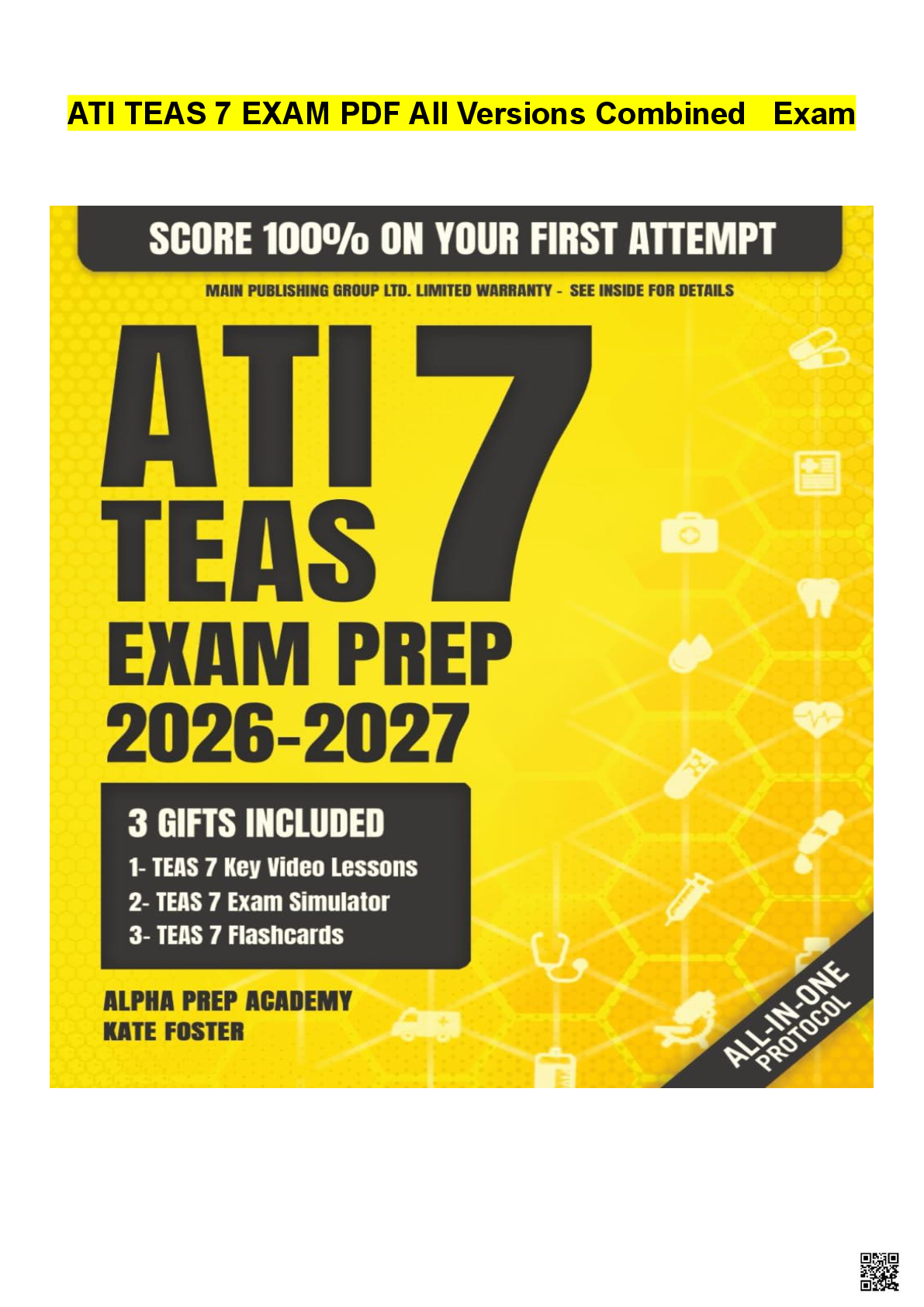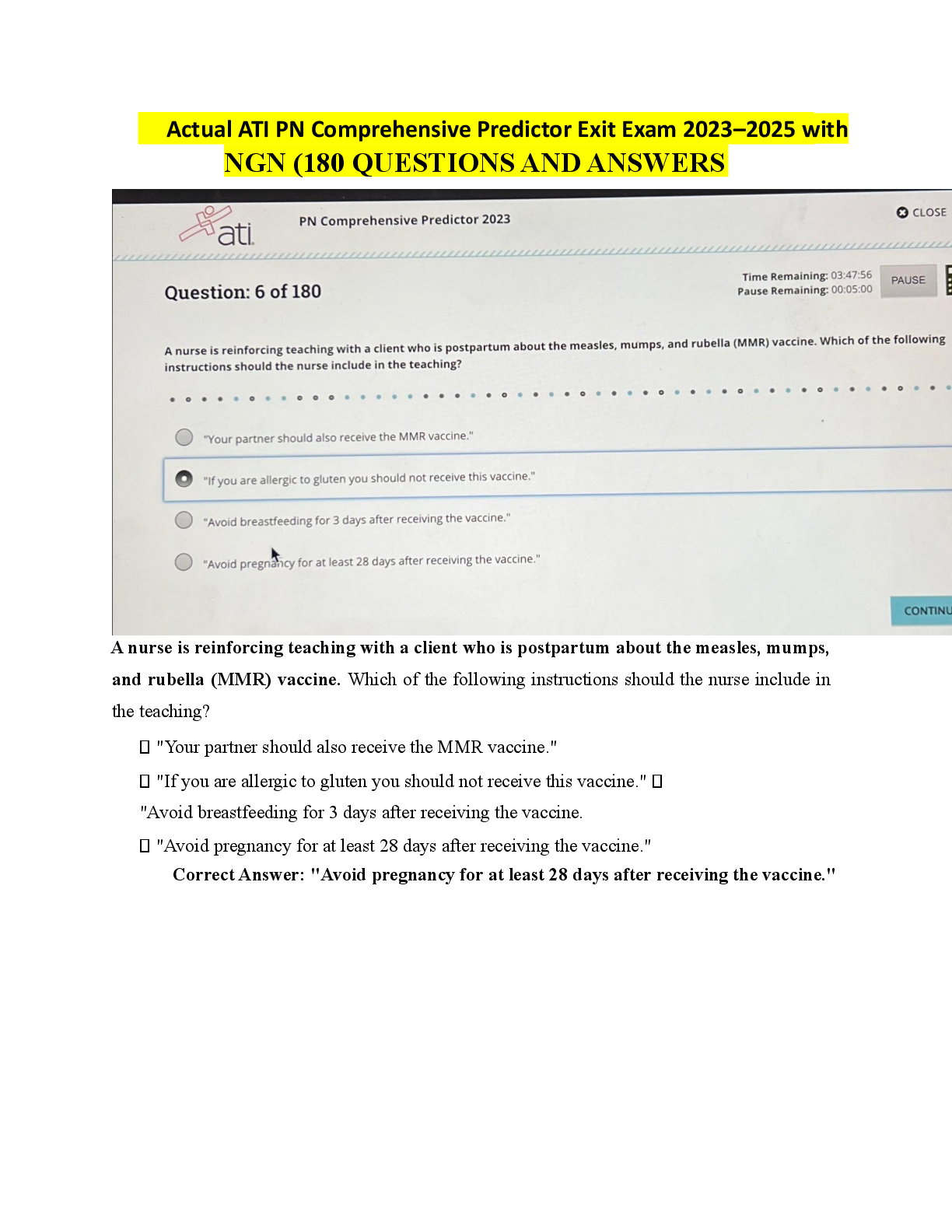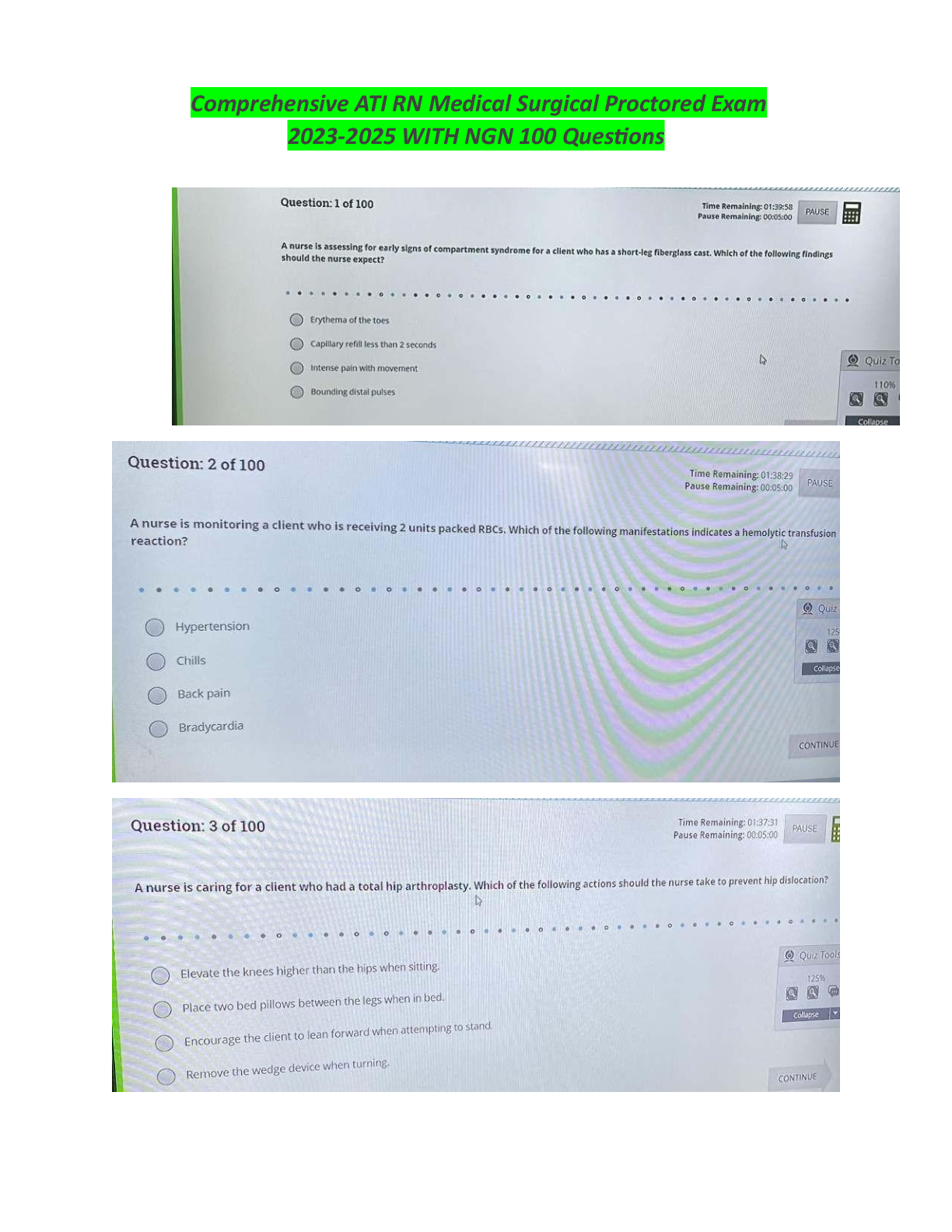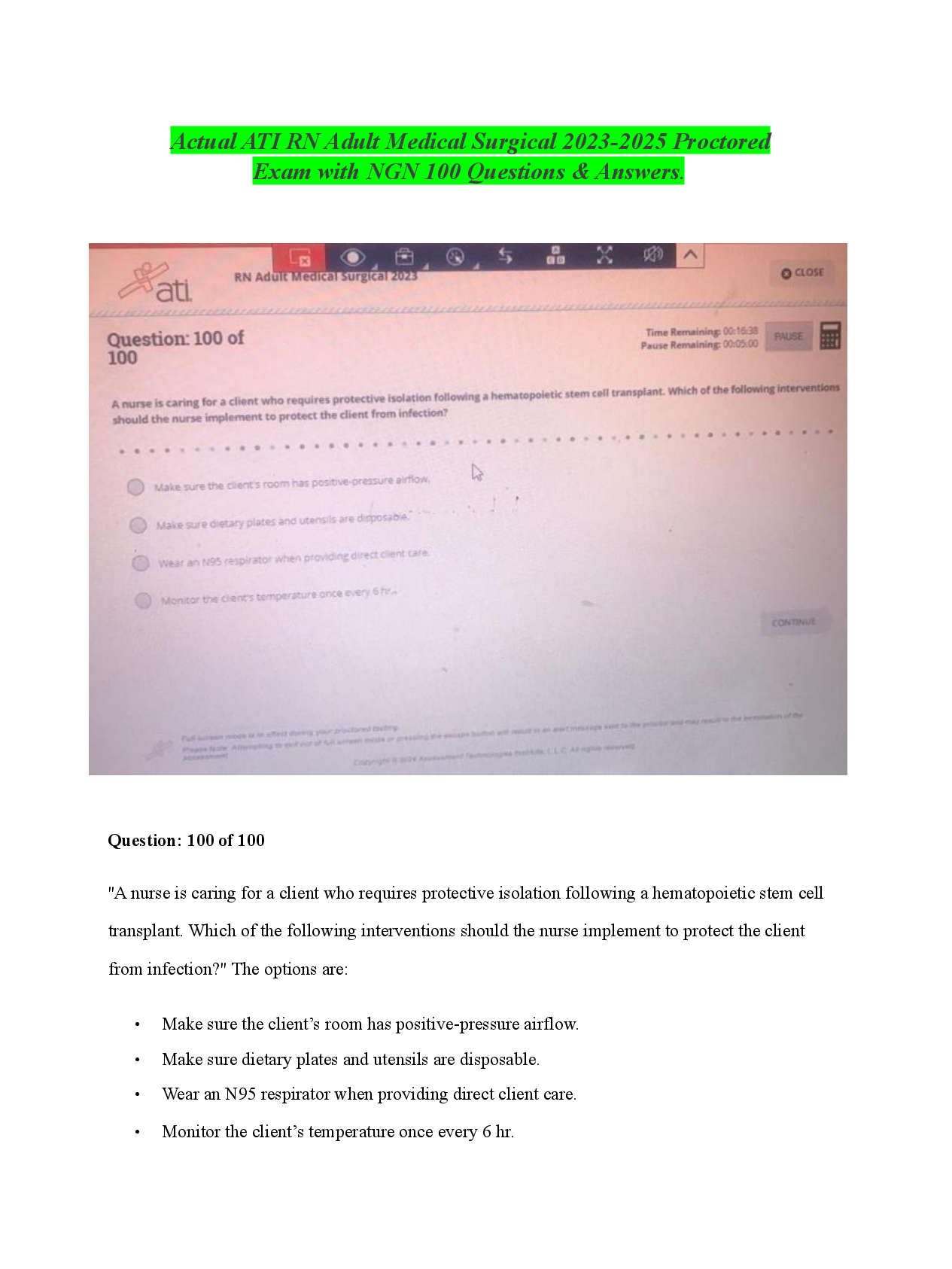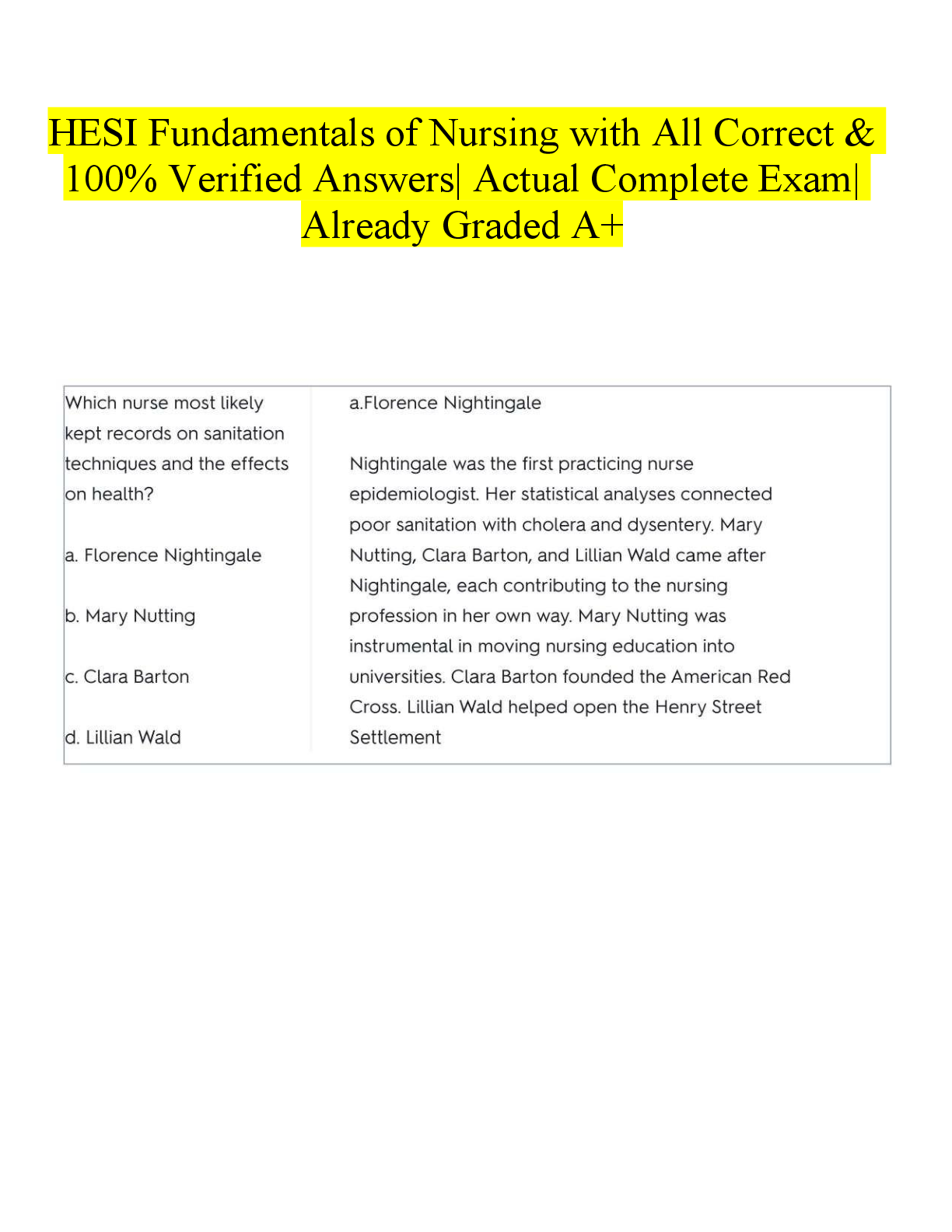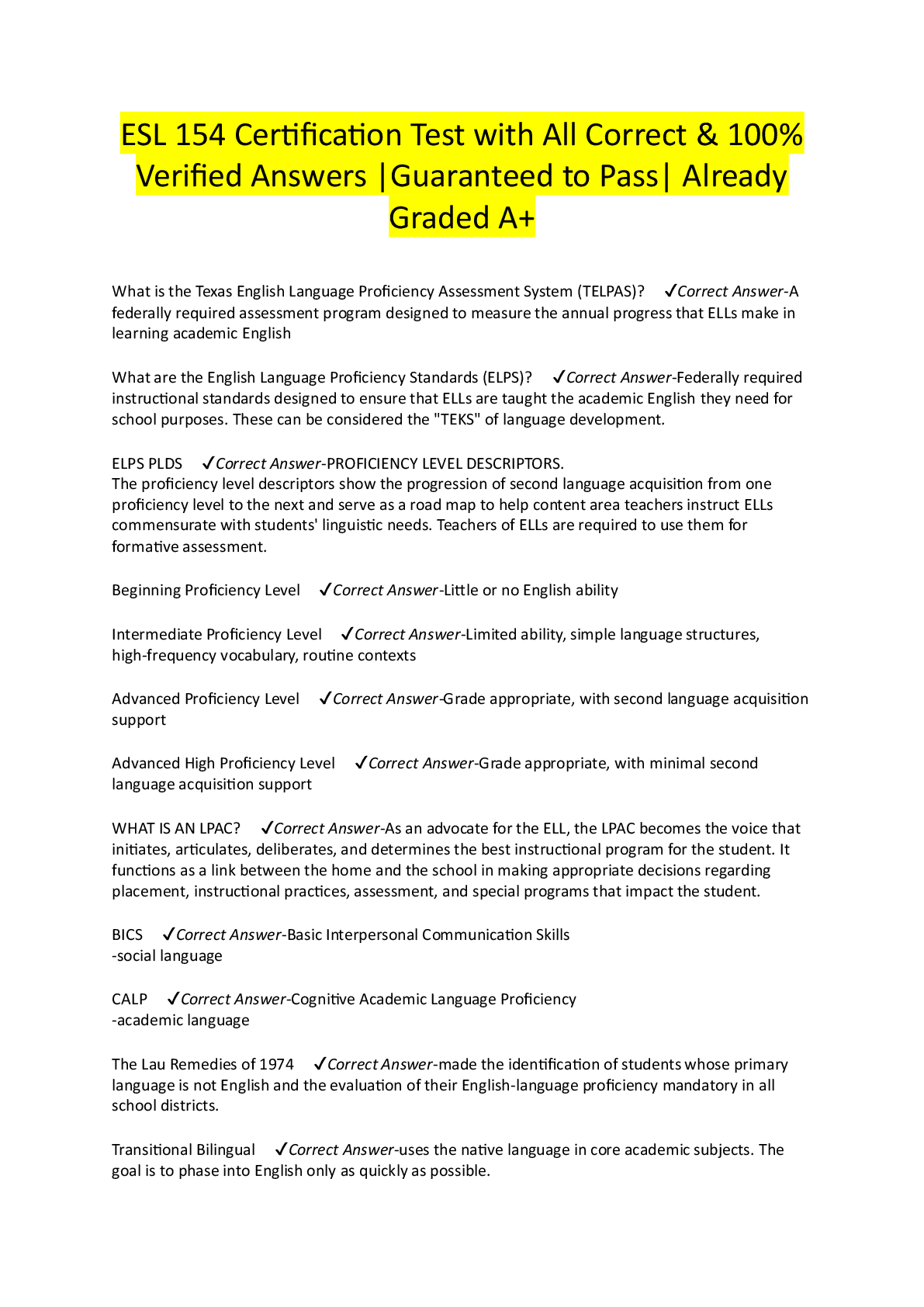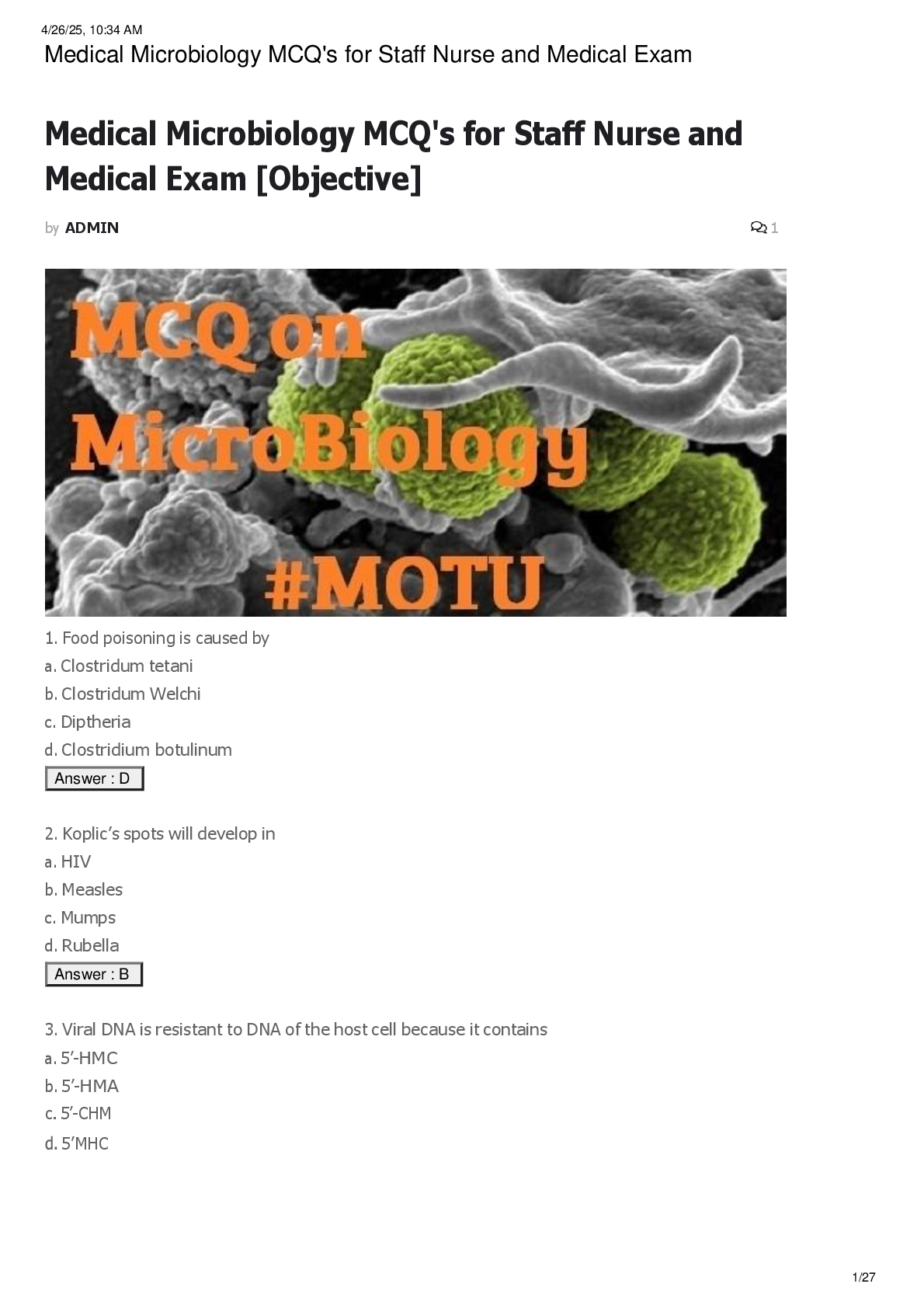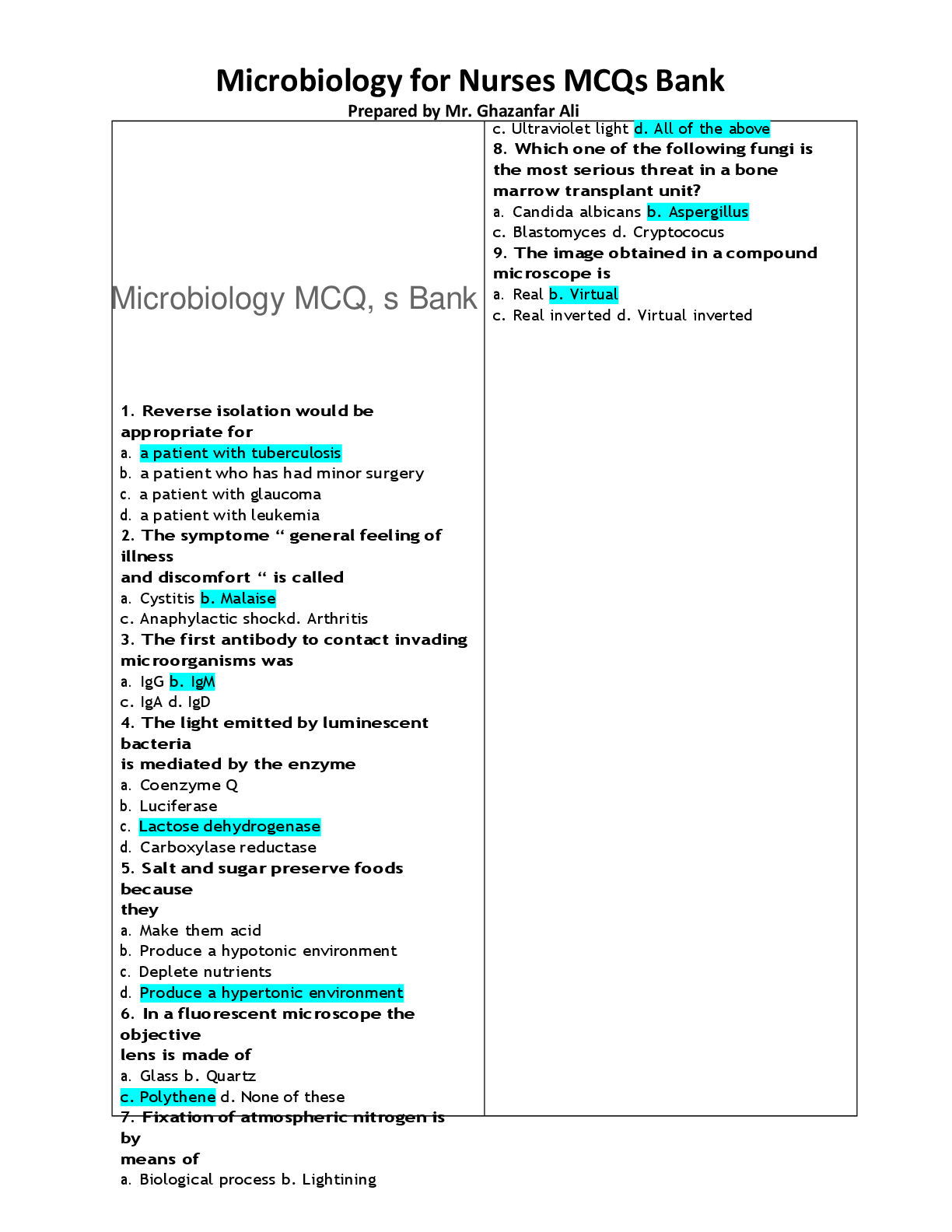Military Studies > EXAM > SEJPME I Module Review Questions 2019/2020 | SEJPME I Module Review Questions_UPDATED (All)
SEJPME I Module Review Questions 2019/2020 | SEJPME I Module Review Questions_UPDATED
Document Content and Description Below
SEJPME I Module Review Questions 2019/2020 – University of Maryland What WWII conference established the Joint chiefs of staff? -First Washington conference (ARCADIA) The 1986 Goldwater-Nichols ... Act___________. -clarified the chain of command and civilian control of the U.S. Military The chairman of the joint chiefs of staff provides a channel of communication between the president / SECDEF and the combatant commanders -True National security agency (NSA) provides which of the following support: (select all that apply) -Solutions, products, and services The north American aerospace defense command (NORAD) is operated by which countries? (select all that apply) -Canada and United states The missile defense agency (MDA) works with the combatant commanders (ccdrs) of which commands? (select all that apply) -United States Northern command (USNORTHCOM); United States Pacific Command (USPACOM); United States Strategic Command (USSTRATCOM) Combatant commanders and subordinate joint force commanders must work with U.S. ambassadors (or diplomatic missions), department of state, and other agencies to best integrate the military actions with the diplomatic, economic, and informational instruments of national power to promote _____-Unity of effort The purpose of specifying the ____ is to direct every military operation toward a clearly defined, decisive, and achievable goal. -objective The purpose of ___________ is to concentrate the effects of combat power at the most advantageous place and time to produce decisive results. -mass Various joint operations such as a show of force or sanctions enforcement support ___________ by demonstrating national resolve and willingness to use force when necessary -deterrence These operations are typically limited in scope and scale and conducted to achieve a very specific objective in an operational area. They include noncombatant evacuation operations, peace operations, foreign humanitarian assistance, recovery operations, consequence management, strikes, raids, homeland defense, and defense support of civil authorities. -crisis response and limited-contingency operations A particular type of operation is not doctrinally fixed and could shift within the range of military operations, for example a counterinsurgency operation escalating from a security cooperation activity into a major operation or campaign -True The range of military operations includes these three categories of operations: (1) military engagement, security cooperation, and deterrence; (2) crisis response and limited contingency operations; and _______ -major operations and campaignsThe JTF commander facilitates unified action and gains a greater understanding of the roles of igos and ngos and how they influence mission accomplishment by establishing a _____________ -civil-military operations Center (CMOC) In most situations, igos and ngos need which of these military capabilities? -logistics, communications, and security ____________ are independent, diverse, flexible, grassroots-focused, primary relief providers that are frequently on the scene before the U.S. military and will most likely remain long after military forces have departed. -ngos The __________ is an interagency staff group that establishes or enhances regular, timely, and collaborative working relationships between other government agencies (e.g., CIA, DOS, FBI), representatives, and military operational planners at the combatant commands. -JIACG The country team provides for rapid interagency consultation and action on recommendations from the field. Dod is normally represented on the country team by which of the following? -Defense Attaché and the security cooperation organization It is imperative that the combatant commander or JTF commander coordinate closely with the ______________ on military activities in a particular country because, while not authorized to command military forces, he or she can deny military actions -Ambassador _________________ is a violent struggle among state and non-state actors for legitimacy and influence over the relevant population(s). It favors indirect and symmetric approaches, though it may employ the full range of military and other capacities, in order to erode an adversary’s power, influence, and will.-Irregular Warfare The ability of the U.S. to achieve its national strategic objectives is dependent on the effectiveness of the U.S. government in employing the instruments of national power, which are ______. -Diplomatic, informational, military, and economic The president of the United States provides guidance for developing, applying, and coordinating the instruments of national power to achieve objectives that contribute to national security in the ________ -National Security Strategy The ________ signed by the chairman of the Joint Chiefs of Staff, provides guidance for distributing and applying military power to attain national strategic objectives. It describes the armed forces plan to achieve military objectives in the near term and provides the vision for ensuring they remain decisive in the future. -National military strategy The statutory members of the national Security Council are ____________ -President, Vice President, Secretary of State, Secretary of Defense, Secretary of Energy The ______ is the president’s principal forum for considering national security policy matters with his senior national security advisors and cabinet officials -National Security Council The operational chain of command runs directly from the president to the secretary of defense and then to the ____________ -Combatant commanders The non-operational chain of command runs directly from the president to the secretary of defense and then to the _______________ -Secretaries of the military departments and then to the service chiefsThe ____________ outranks all other officers of the armed forces but may not exercise military command over any of the armed forces. This officer is the principal military advisor to the president, the national Security Council, and the secretary of defense. -Chairman of the Joint Chiefs of Staff A unified or specified command with a broad continuing mission under a single commander established and so designated by the president, through the secretary of defense and with the advice and assistance of the chairman of the Joint Chiefs of Staff is called a ______________ -Component Command A ___________ is a joint force that is constituted and so designated by the SECDEF, a combatant commander, a subordinate unified commander, or an existing JTF commander to accomplish missions with specific, limited objectives and which do not require overall centralized control of logistics. It is dissolved when the purpose for which it was created has been achieved or when it is no longer required. -Joint Task Force The term joint force commander refers exclusively to the following three (3) types of commanders: -Combatant commander, subordinate unified commander, and joint task force commander Joint force air component commander (JFACC), Joint force land component commander (JFLCC), and joint force maritime component commander (JFMCC) are all examples of __________ -Functional component commander These commands are established by combatant commanders when authorized by the SECDEF through the CJCS to conduct operations on a continuing basis in accordance with the criteria set forth for unified commands. They may be established on ageographic area basis such as United States forces japan or on a functional basis such as special operations command, pacific. -Subordinate unified commands Combatant commanders exercise _______ (command authority) over assigned forces. This is the broadest command authority and may not be delegated or transferred. -Combatant command (COCOM) ____________ is the authority to perform those functions of command over subordinate forces involving organizing and employing commands and forces, assigning tasks, designating objectives, and giving authoritative direction necessary to accomplish the mission. It includes authoritative direction over all aspects of military operations and joint training necessary to accomplish missions assigned to the command. -Operational control (OPCON) The four categories of support are ________ -General, tactical, operational, and strategic Command authority over assigned or attached forces or commands, or military capability or forces made available for tasking, that is limited to the detailed direction and control of movements or maneuvers within the operational area necessary to accomplish missions or tasks assigned is known as _________ -Tactical Control (TACON) The command authority established by a superior commander between subordinate commanders when one organization should aid, protect, complement, or sustain another force is called ____ -Support Which of the following are instruments of national power? (Select all that apply) -Economics, information, the military, diplomacyThe relevance of the interagency process at the strategic level to the combatant commander and the U.S. military is that the process yields America’s major national security policy decisions. -True Which organization is the principal policy-making forum responsible for the nation’s security strategy? -National Security Council (NSC) What are key criticisms of the interagency process? (Select all the apply) -It is often time consuming, it can be cumbersome, no one is in charge, except the president Which of the following options represent the statutory advisors of the national Security Council? -Chairman of the Joint Chiefs of Staff and director of national intelligence The national Security Council comprises these three levels of formal interagency committees for coordinating and making decisions on national security issues. -Principals, deputies, and interagency policy The __________ is the principal military advisor to the president, the national Security Council, and the secretary of defense. -Chairman of the Joint Chiefs of Staff The concept of _________ highlights the synergistic application of all the instruments of national power and includes the actions of non-military organizations as well as military forces. -Unified action U.S. military forces are authorized under certain conditions to provide assistance to U.S. civil authorities for disasters, catastrophes, infrastructure protection, and otheremergencies. This assistance is known as __________ within the defense community because the assistance will always be in support of a lead federal agency. -Civil support The purpose of __________ is to maintain legal and moral authority in the conduct of operations. It is based on the actual and perceived legality, morality, and rightness of the actions from the various perspectives of interested audiences - - - - - - - - - Continued [Show More]
Last updated: 3 years ago
Preview 1 out of 24 pages
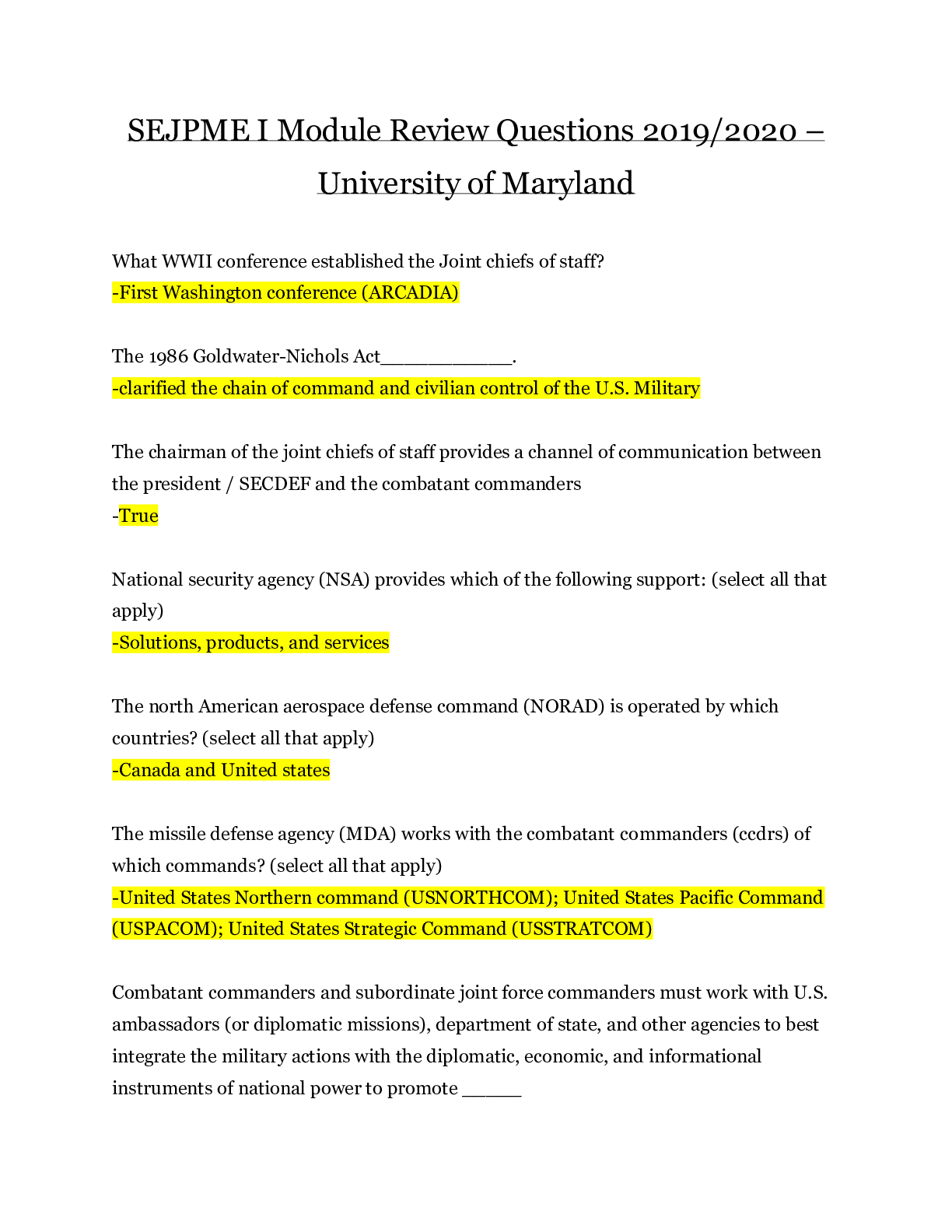
Buy this document to get the full access instantly
Instant Download Access after purchase
Buy NowInstant download
We Accept:

Reviews( 0 )
$13.00
Can't find what you want? Try our AI powered Search
Document information
Connected school, study & course
About the document
Uploaded On
Mar 04, 2021
Number of pages
24
Written in
All
Additional information
This document has been written for:
Uploaded
Mar 04, 2021
Downloads
0
Views
251








 – University of the People.png)




